Dual-Polarization Radar-Based Quantitative Precipitation Estimation of Mountain Terrain Using Multi-Disdrometer Data
Abstract
1. Introduction
2. Observational Data and Methodology
2.1. Intensive Field Observation Campaign
2.1.1. Disdrometer Observation Network on Jeju Island
2.1.2. Calculating the Number Concentration
2.1.3. Retrieving the Dual-Polarization Parameters with T-Matrix
2.2. Operational Data
2.2.1. Dual-Polarization Radar and HSR
2.2.2. Ensemble of Rain Rate Relationships with HSA
2.2.3. Spatial Optimization of Rainfall Estimation
3. Results
3.1. Rainfall Estimation Relationships with Dual-Polarization Radar Parameters
3.2. Optimization of Rainfall Estimate with the Ensemble Approach
3.3. Spatial Correction of the Rainfall Fields
4. Summary and Conclusions
Author Contributions
Funding
Institutional Review Board Statement
Informed Consent Statement
Data Availability Statement
Conflicts of Interest
Appendix A
| S1 | Equation | RMSE | NE | CORR |
|---|---|---|---|---|
| R(ZH) | R = 0.0389ZH0.65761 | 1.947 | 0.000041 | 0.945 |
| R(KDP) | R = 47.2049KDP0.72784 | 1.068 | 0.000031 | 0.981 |
| R(ZH, ZDR) | R = 0.042ZH0.7008ZDR−4.5108 | 1.893 | 0.000039 | 0.976 |
| R(ZH, KDP) | R = 0.011ZH0.7542KDP−0.1536 | 1.858 | 0.000042 | 0.938 |
| R(ZDR, KDP) | R = 35.918ZDR−1.0523KDP0.6414 | 2.035 | 0.000045 | 0.976 |
| R(ZH, ZDR, KDP) | R = 0.005ZH0.9129ZDR−4.8768KDP−0.2149 | 1.836 | 0.000038 | 0.977 |
| S2 | Equation | RMSE | NE | CORR |
| R(ZH) | R = 0.0357ZH0.67169 | 1.707 | 0.000046 | 0.967 |
| R(KDP) | R = 50.8550KDP0.74610 | 1.065 | 0.000035 | 0.986 |
| R(ZH, ZDR) | R = 0.040ZH0.7015ZDR−3.8854 | 2.388 | 0.000048 | 0.977 |
| R(ZH, KDP) | R = 0.008ZH0.7879KDP−0.1773 | 1.859 | 0.000049 | 0.961 |
| R(ZDR, KDP) | R = 31.234ZDR−0.0326KDP0.6281 | 2.560 | 0.000056 | 0.974 |
| R(ZH, ZDR, KDP) | R = 0.004ZH0.9269ZDR−4.2899KDP−0.2275 | 2.299 | 0.000046 | 0.979 |
| S3 | Equation | RMSE | NE | CORR |
| R(ZH) | R = 0.0291ZH0.68783 | 1.560 | 0.000072 | 0.964 |
| R(KDP) | R = 49.9538KDP0.75820 | 0.887 | 0.000053 | 0.985 |
| R(ZH, ZDR) | R = 0.047ZH0.6553ZDR−3.2141 | 2.442 | 0.000084 | 0.966 |
| R(ZH, KDP) | R = 0.104ZH0.5251KDP0.0651 | 1.880 | 0.000082 | 0.968 |
| R(ZDR, KDP) | R = 31.641ZDR−0.7763KDP0.6341 | 2.424 | 0.000086 | 0.968 |
| R(ZH, ZDR, KDP) | R = 0.023ZH0.7233ZDR−3.3842KDP−0.0685 | 2.439 | 0.000084 | 0.966 |
| S4 | Equation | RMSE | NE | CORR |
| R(ZH) | R = 0.0369ZH0.66180 | 2.721 | 0.000033 | 0.919 |
| R(KDP) | R = 48.5628KDP0.73833 | 1.462 | 0.000025 | 0.970 |
| R(ZH, ZDR) | R = 0.047ZH0.6855ZDR−4.6863 | 2.916 | 0.000031 | 0.945 |
| R(ZH, KDP) | R = 0.079ZH0.5559KDP0.0289 | 2.294 | 0.000033 | 0.929 |
| R(ZDR, KDP) | R = 37.293ZDR−1.6821KDP0.6426 | 2.961 | 0.000033 | 0.952 |
| R(ZH, ZDR, KDP) | R = 0.011ZH0.8256ZDR−5.0646KDP−0.1396 | 2.900 | 0.000031 | 0.945 |
| S5 | Equation | RMSE | NE | CORR |
| R(ZH) | R = 0.0575ZH0.64395 | 2.471 | 0.000059 | 0.945 |
| R(KDP) | R = 56.5972KDP0.71370 | 1.379 | 0.000044 | 0.979 |
| R(ZH, ZDR) | R = 0.043ZH0.7528ZDR−7.4426 | 2.649 | 0.000050 | 0.959 |
| R(ZH, KDP) | R = 0.030ZH0.6928KDP−0.0582 | 2.165 | 0.000055 | 0.941 |
| R(ZDR, KDP) | R = 58.388ZDR−3.7367KDP0.6854 | 2.995 | 0.000060 | 0.968 |
| R(ZH, ZDR, KDP) | R = 0.008ZH0.9155ZDR−7.8030KDP−0.1609 | 2.580 | 0.000049 | 0.961 |
| S6 | Equation | RMSE | NE | CORR |
| R(ZH) | R = 0.0404ZH0.66853 | 1.918 | 0.000026 | 0.960 |
| R(KDP) | R = 52.4869KDP0.72923 | 1.148 | 0.000019 | 0.984 |
| R(ZH, ZDR) | R = 0.043ZH0.7192ZDR−5.1591 | 2.203 | 0.000025 | 0.981 |
| R(ZH, KDP) | R = 0.017ZH0.7312KDP−0.1140 | 1.891 | 0.000026 | 0.957 |
| R(ZDR, KDP) | R = 36.494ZDR−0.7470KDP0.6334 | 2.507 | 0.000031 | 0.979 |
| R(ZH, ZDR, KDP) | R = 0.008ZH0.8891ZDR−5.5056KDP−0.1682 | 2.122 | 0.000024 | 0.982 |
| S7 | Equation | RMSE | NE | CORR |
| R(ZH) | R = 0.0371ZH0.67122 | 1.077 | 0.000064 | 0.956 |
| R(KDP) | R = 50.4189KDP0.73234 | 0.872 | 0.000055 | 0.969 |
| R(ZH, ZDR) | R = 0.042ZH0.7460ZDR−8.1627 | 1.996 | 0.000060 | 0.894 |
| R(ZH, KDP) | R = 0.015ZH0.7230KDP−0.1251 | 1.206 | 0.000065 | 0.952 |
| R(ZDR, KDP) | R = 32.844ZDR−2.8589KDP0.5979 | 2.221 | 0.000077 | 0.904 |
| R(ZH, ZDR, KDP) | R = 0.007ZH0.9252ZDR−8.4534KDP−0.1701 | 1.919 | 0.000057 | 0.903 |
| S8 | Equation | RMSE | NE | CORR |
| R(ZH) | R = 0.0504ZH0.64806 | 2.485 | 0.000036 | 0.926 |
| R(KDP) | R = 52.0774KDP0.70816 | 1.332 | 0.000029 | 0.972 |
| R(ZH, ZDR) | R = 0.042ZH0.7653ZDR−7.9757 | 2.200 | 0.000027 | 0.944 |
| R(ZH, KDP) | R = 0.014ZH0.7618KDP−0.1394 | 2.452 | 0.000035 | 0.915 |
| R(ZDR, KDP) | R = 58.268ZDR−4.0993KDP0.6685 | 2.596 | 0.000036 | 0.946 |
| R(ZH, ZDR, KDP) | R = 0.007ZH0.9357ZDR−8.1194KDP−0.1700 | 2.109 | 0.000026 | 0.949 |
| S9 | Equation | RMSE | NE | CORR |
| R(ZH) | R = 0.1181ZH0.55311 | 2.539 | 0.000115 | 0.945 |
| R(KDP) | R = 50.3939KDP0.64553 | 2.031 | 0.000111 | 0.968 |
| R(ZH, ZDR) | R = 0.052ZH0.7473ZDR−7.9144 | 5.608 | 0.000113 | 0.813 |
| R(ZH, KDP) | R = 0.009ZH0.7997KDP−0.2066 | 3.240 | 0.000110 | 0.933 |
| R(ZDR, KDP) | R = 34.728ZDR−2.9961KDP0.5528 | 6.163 | 0.000142 | 0.809 |
| R(ZH, ZDR, KDP) | R = 0.005ZH0.9754ZDR−8.0061KDP−0.2175 | 5.269 | 0.000105 | 0.851 |
| S10 | Equation | RMSE | NE | CORR |
| R(ZH) | R = 0.0430ZH0.63962 | 1.469 | 0.000047 | 0.955 |
| R(KDP) | R = 43.3704KDP0.70726 | 0.876 | 0.000036 | 0.979 |
| R(ZH, ZDR) | R = 0.055ZH0.6415ZDR−3.5784 | 1.993 | 0.000043 | 0.953 |
| R(ZH, KDP) | R = 0.047ZH0.5990KDP−0.0292 | 1.408 | 0.000046 | 0.957 |
| R(ZDR, KDP) | R = 29.611ZDR−0.7941KDP0.6104 | 1.967 | 0.000047 | 0.961 |
| R(ZH, ZDR, KDP) | R = 0.017ZH0.7560ZDR−3.8443KDP−0.1160 | 1.980 | 0.000043 | 0.953 |
| S1 | Equation | RMSE | NE | CORR |
|---|---|---|---|---|
| R(ZH) | R = 0.0389ZH0.65739 | 1.957 | 0.000041 | 0.944 |
| R(KDP) | R = 46.3053KDP0.72766 | 1.070 | 0.000031 | 0.981 |
| R(ZH, ZDR) | R = 0.042ZH0.7008ZDR−4.5119 | 1.893 | 0.000039 | 0.976 |
| R(ZH, KDP) | R = 0.011ZH0.7526KDP−0.1522 | 1.863 | 0.000042 | 0.938 |
| R(ZDR, KDP) | R = 35.344ZDR−1.0554KDP0.6414 | 2.035 | 0.000045 | 0.976 |
| R(ZH, ZDR, KDP) | R = 0.005ZH0.9115ZDR−4.8764KDP−0.2136 | 1.836 | 0.000038 | 0.977 |
| S2 | Equation | RMSE | NE | CORR |
| R(ZH) | R = 0.0357ZH0.67142 | 1.711 | 0.000047 | 0.967 |
| R(KDP) | R = 49.8511KDP0.74583 | 1.066 | 0.000035 | 0.986 |
| R(ZH, ZDR) | R = 0.040ZH0.7014ZDR−3.8879 | 2.388 | 0.000048 | 0.977 |
| R(ZH, KDP) | R = 0.008ZH0.7886KDP−0.1783 | 1.861 | 0.000049 | 0.961 |
| R(ZDR, KDP) | R = 30.906ZDR−0.0570KDP0.6289 | 2.559 | 0.000055 | 0.974 |
| R(ZH, ZDR, KDP) | R = 0.004ZH0.9283ZDR−4.2948KDP−0.2290 | 2.299 | 0.000046 | 0.979 |
| S3 | Equation | RMSE | NE | CORR |
| R(ZH) | R = 0.0291ZH0.68757 | 1.566 | 0.000072 | 0.964 |
| R(KDP) | R = 48.9830KDP0.75822 | 0.888 | 0.000053 | 0.985 |
| R(ZH, ZDR) | R = 0.047ZH0.6552ZDR−3.2163 | 2.442 | 0.000084 | 0.966 |
| R(ZH, KDP) | R = 0.105ZH0.5238KDP0.0664 | 1.880 | 0.000082 | 0.968 |
| R(ZDR, KDP) | R = 31.152ZDR−0.7808KDP0.6341 | 2.424 | 0.000086 | 0.968 |
| R(ZH, ZDR, KDP) | R = 0.023ZH0.7239ZDR−3.3888KDP−0.0692 | 2.438 | 0.000084 | 0.966 |
| S4 | Equation | RMSE | NE | CORR |
| R(ZH) | R = 0.0369ZH0.66152 | 2.736 | 0.000033 | 0.918 |
| R(KDP) | R = 47.6293KDP0.73827 | 1.465 | 0.000025 | 0.970 |
| R(ZH, ZDR) | R = 0.047ZH0.6854ZDR−4.6859 | 2.916 | 0.000031 | 0.945 |
| R(ZH, KDP) | R = 0.080ZH0.5545KDP0.0301 | 2.296 | 0.000033 | 0.929 |
| R(ZDR, KDP) | R = 36.783ZDR−1.6926KDP0.6429 | 2.960 | 0.000033 | 0.952 |
| R(ZH, ZDR, KDP) | R = 0.011ZH0.0.8249ZDR−5.0622KDP−0.1391 | 2.901 | 0.000031 | 0.945 |
| S5 | Equation | RMSE | NE | CORR |
| R(ZH) | R = 0.0575ZH0.64375 | 2.479 | 0.000059 | 0.945 |
| R(KDP) | R = 55.5569KDP0.71362 | 1.381 | 0.000044 | 0.979 |
| R(ZH, ZDR) | R = 0.043ZH0.7527ZDR−7.4415 | 2.649 | 0.000050 | 0.959 |
| R(ZH, KDP) | R = 0.030ZH0.6923KDP−0.0579 | 2.171 | 0.000055 | 0.941 |
| R(ZDR, KDP) | R = 57.343ZDR−3.7328KDP0.6854 | 2.995 | 0.000060 | 0.968 |
| R(ZH, ZDR, KDP) | R = 0.008ZH0.9154ZDR−7.8027KDP−0.1609 | 2.580 | 0.000049 | 0.961 |
| S6 | Equation | RMSE | NE | CORR |
| R(ZH) | R = 0.0404ZH0.66833 | 1.924 | 0.000026 | 0.960 |
| R(KDP) | R = 51.4925KDP0.72911 | 1.150 | 0.000019 | 0.983 |
| R(ZH, ZDR) | R = 0.043ZH0.7191ZDR−5.1602 | 2.203 | 0.000025 | 0.981 |
| R(ZH, KDP) | R = 0.017ZH0.7304KDP−0.1133 | 1.894 | 0.000026 | 0.956 |
| R(ZDR, KDP) | R = 35.917ZDR−0.7495KDP0.6334 | 2.506 | 0.000031 | 0.979 |
| R(ZH, ZDR, KDP) | R = 0.008ZH0.8885ZDR−5.5065KDP−0.1678 | 2.122 | 0.000024 | 0.982 |
| S7 | Equation | RMSE | NE | CORR |
| R(ZH) | R = 0.0371ZH0.67104 | 1.078 | 0.000064 | 0.956 |
| R(KDP) | R = 49.4729KDP0.73230 | 0.872 | 0.000055 | 0.969 |
| R(ZH, ZDR) | R = 0.042ZH0.7459ZDR−8.1628 | 1.997 | 0.000060 | 0.894 |
| R(ZH, KDP) | R = 0.015ZH0.7234KDP−0.1256 | 1.206 | 0.000065 | 0.952 |
| R(ZDR, KDP) | R = 32.427ZDR−2.8688KDP0.5982 | 2.221 | 0.000077 | 0.904 |
| R(ZH, ZDR, KDP) | R = 0.007ZH0.9257ZDR−8.4539KDP−0.1707 | 1.920 | 0.000057 | 0.903 |
| S8 | Equation | RMSE | NE | CORR |
| R(ZH) | R = 0.0504ZH0.64787 | 2.499 | 0.000036 | 0.925 |
| R(KDP) | R = 51.1323KDP0.70813 | 1.335 | 0.000029 | 0.972 |
| R(ZH, ZDR) | R = 0.042ZH0.7652ZDR−7.9749 | 2.201 | 0.000027 | 0.944 |
| R(ZH, KDP) | R = 0.014ZH0.7610KDP−0.1388 | 2.466 | 0.000035 | 0.915 |
| R(ZDR, KDP) | R = 57.234ZDR−4.0948KDP0.6684 | 2.596 | 0.000036 | 0.946 |
| R(ZH, ZDR, KDP) | R = 0.007ZH0.9353ZDR−8.1196KDP−0.1696 | 2.110 | 0.000026 | 0.949 |
| S9 | Equation | RMSE | NE | CORR |
| R(ZH) | R = 0.1183ZH0.55280 | 2.545 | 0.000116 | 0.945 |
| R(KDP) | R = 49.5342KDP0.64540 | 2.031 | 0.000111 | 0.968 |
| R(ZH, ZDR) | R = 0.052ZH0.7471ZDR−7.9075 | 5.609 | 0.000113 | 0.813 |
| R(ZH, KDP) | R = 0.009ZH0.7990KDP−0.2062 | 3.262 | 0.000111 | 0.932 |
| R(ZDR, KDP) | R = 34.201ZDR−2.9886KDP0.5526 | 6.163 | 0.000142 | 0.809 |
| R(ZH, ZDR, KDP) | R = 0.005ZH0.9751ZDR−8.0012KDP−0.2173 | 5.271 | 0.000105 | 0.851 |
| S10 | Equation | RMSE | NE | CORR |
| R(ZH) | R = 0.0430ZH0.63940 | 1.475 | 0.000047 | 0.955 |
| R(KDP) | R = 42.5642KDP0.70709 | 0.877 | 0.000036 | 0.979 |
| R(ZH, ZDR) | R = 0.055ZH0.6415ZDR−3.5808 | 1.993 | 0.000043 | 0.953 |
| R(ZH, KDP) | R = 0.047ZH0.5995KDP−0.0298 | 1.408 | 0.000046 | 0.957 |
| R(ZDR, KDP) | R = 29.116ZDR−0.7905KDP0.6102 | 1.966 | 0.000047 | 0.961 |
| R(ZH, ZDR, KDP) | R = 0.017ZH0.7572ZDR−3.8506KDP−0.1172 | 1.980 | 0.000043 | 0.953 |
References
- Yu, N.; Gaussiat, N.; Tabary, P. Polarimetric X-band weather radars for quantitative precipitation estimation in mountainous regions. Q. J. R. Meteorol. Soc. 2018, 144, 2603–2619. [Google Scholar] [CrossRef]
- Kim, T.J.; Kwon, H.H.; Lima, C. A Bayesian partial pooling approach to mean field bias correction of weather radar rainfall estimates: Application to Osungsan weather radar in South Korea. J. Hydrol. 2018, 565, 14–26. [Google Scholar] [CrossRef]
- Chang, P.L.; Zhang, J.; Tang, Y.S.; Tang, L.; Lin, P.F.; Langston, C.; Kaney, B.; Chen, C.R.; Howard, K. An operational multi-radar multi-sensor QPE system in Taiwan. Bull. Amer. Meteor. 2018, 102, E555–E577. [Google Scholar] [CrossRef]
- Derin, Y.; Anagnostou, E.; Anagnostou, M.N.; Kalogiros, K.; Casella, D.; Marra, A.C.; Panegrossi, G.; Sanò, P. Passive microwave rainfall error analysis using high-resolution x-band dual-polarization radar observations in complex terrain. IEEE Trans. Geosci. Remote Sens. 2018, 56, 2565–2586. [Google Scholar] [CrossRef]
- Kirstetter, P.E.; Gourley, J.J.; Hong, Y.; Zhang, J.; Moazamigoodarzi, S.; Langston, C.; Arthur, A. Probabilistic precipitation rate estimates with ground-based radar networks. Water Resour. 2015, 51, 1422–1442. [Google Scholar] [CrossRef]
- Chen, H.; Cifelli, R.; White, A. Improving operational radar rainfall estimates using profiler observations over complex terrain in Northern California. IEEE Trans. Geosci. Remote Sens. 2019, 58, 1821–1832. [Google Scholar] [CrossRef]
- Kurdzo, J.M.; Joback, E.F.; Kirstetter, P.E.; Cho, J.Y. Geospatial QPE accuracy dependence on weather radar network configurations. J. Appl. Meteorol. Climatol. 2020, 59, 1773–1792. [Google Scholar] [CrossRef]
- Giangrande, S.E.; Ryzhkov, A.V. Estimation of rainfall based on the results of polarimetric echo classification. J. Appl. Meteorol. Climatol. 2008, 47, 2445–2462. [Google Scholar] [CrossRef]
- Cifelli, R.; Chandrasekar, V.; Lim, S.; Kennedy, P.C.; Wang, Y.; Rutledge, S.A. A new dual-polarization radar rainfall algorithm: Application in Colorado precipitation events. J. Atmos. Ocean. Technol. 2011, 28, 352–364. [Google Scholar] [CrossRef]
- You, C.H.; Lee, D.I. Decadal variation in raindrop size distributions in Busan, Korea. Adv. Meteorol. 2015, 2015, 329327. [Google Scholar] [CrossRef]
- You, C.H.; Kang, M.Y.; Hwang, Y.; Yee, J.J.; Jang, M.; Lee, D.I. A statistical approach to radar rainfall estimates using polarimetric variables. Atmos. Res. 2018, 209, 65–75. [Google Scholar] [CrossRef]
- Zhang, Y.; Liu, L.; Bi, S.; Wu, Z.; Shen, P.; Ao, Z.; Chen, C.; Zhang, Y. Analysis of dual-polarimetric radar variables and quantitative precipitation estimators for landfall typhoons and squall lines based on disdrometer data in southern China. Atmosphere 2019, 10, 30. [Google Scholar] [CrossRef]
- Bech, J.; Codian, B.; Lorente, J.; Bebbington, D. The sensitivity of single polarization weather radar beam blockage correction to variability in the vertical refractivity gradient. J. Atmos. Ocean. Technol. 2003, 20, 845–855. [Google Scholar] [CrossRef]
- Shakti, P.C.; Maki, M. Challenges in Estimating Quantitative Precipitation Estimation (QPE) Using Weather Radar Observation Over the Mountainous Country of Nepal. Hydro Nepal: Journal of Water. Energy Environ. 2017, 21, 50–59. [Google Scholar]
- Zhang, D.L.; Lin, Y.; Zhao, P.; Yu, X.; Wang, S.; Kang, H.; Ding, Y. The Beijing extreme rainfall of 21 July 2012: “Right results” but for wrong reasons. Geophys. Res. Lett. 2013, 40, 1426–1431. [Google Scholar] [CrossRef]
- Zhang, J.; Qi, Y. A real-time algorithm for the correction of brightband effects in radar-derived QPE. J. Hydrometeorol. 2010, 11, 1157–1171. [Google Scholar] [CrossRef]
- Zhang, J.; Qi, Y.; Howard, K.; Langston, C.; Kaney, B. Radar quality index (RQI)—A combined measure of beam blockage and VPR effects in a national network. IAHS Publ. 2011, 351, 388–393. [Google Scholar]
- Li, Z.; Zhang, Y.; Giangrande, S.E. Rainfall-rate estimation using Gaussian mixture parameter estimator: Training and validation. J. Atmos. Ocean. Technol. 2012, 29, 731–744. [Google Scholar] [CrossRef][Green Version]
- Martet, M.; Thomas, G.; Bernadine, T.; Gaussiat, N. Toward an Ensemble Radar Precipitation Estimation Based on a Dynamic Description of the Measurement Errors. In Proceedings of the 38th Conference on Radar Meteorology, Chicago, IL, USA, 28 August–1 September 2017. [Google Scholar]
- Kang, N.; Joo, H.; Lee, M.; Kim, H.S. Generation of radar rainfall ensemble using probabilistic approach. J. Korea Water Resour. Assoc. 2017, 50, 155–167. [Google Scholar]
- Faure, D.; Delrieu, G.; Gaussiat, N. Impact of the altitudinal gradients of precipitation on the radar QPE bias in the French Alps. Atmosphere 2019, 10, 306. [Google Scholar] [CrossRef]
- Vulpiani, G.; Montopoli, M.; Passeri, L.D.; Gioia, A.G.; Giordano, P.; Marzano, F.S. On the use of dual-polarized C-band radar for operational rainfall retrieval in mountainous areas. J. Appl. Meteorol. Climatol. 2012, 51, 405–425. [Google Scholar] [CrossRef]
- Wang, Y.; Zhang, J.; Chang, P.L.; Langston, C.; Kaney, B.; Tang, L. Operational C-band dual-polarization radar QPE for the subtropical complex terrain of Taiwan. Adv. Meteorol. 2016, 2016, 4294271. [Google Scholar] [CrossRef][Green Version]
- Löffler-Mang, M.; Joss, J. An optical disdrometer for measuring size and velocity of hydrometeors. J. Atmos. Ocean. Technol. 2000, 17, 130–139. [Google Scholar] [CrossRef]
- Atlas, D.; Srivastava, R.C.; Sekhon, R.S. Doppler radar characteristics of precipitation at vertical incidence. Rev. Geophys. 1973, 11, 1–35. [Google Scholar] [CrossRef]
- Friedrich, K.; Kalina, E.A.; Masters, F.J.; Lopez, C.R. Drop-size distributions in thunderstorms measured by optical disdrometers during VORTEX2. Mon. Weather Rev. 2013, 141, 1182–1203. [Google Scholar] [CrossRef]
- Bao, X.; Wu, L.; Tang, B.; Ma, L.; Wu, D.; Tang, J.; Chen, H.; Wu, L. Variable raindrop size distributions in different rainbands associated with typhoon fitow (2013). J. Geophys. Res. Atmos. 2019, 124, 12262–12281. [Google Scholar] [CrossRef]
- Jaffrain, J.; Berne, A. Experimental quantification of the sampling uncertainty associated with measurements from PARSIVEL disdrometers. J. Hydrometeorol. 2011, 12, 352–370. [Google Scholar] [CrossRef]
- Beard, K.V. Terminal velocity and shape of cloud and precipitation drops aloft. J. Atmos. Sci. 1976, 33, 851–864. [Google Scholar] [CrossRef]
- Mishchenko, M.I.; Travis, L.D.; Mackowski, D.W. T-matrix computations of light scattering by nonspherical particles: A review. J. Quant. Spectrosc. Radiat. 1996, 55, 535–575. [Google Scholar] [CrossRef]
- Leinonen, J. High-level interface to T-matrix scattering calculations: Architecture, capabilities and limitations. Opt. Express 2014, 22, 1655–1660. [Google Scholar] [CrossRef]
- Thurai, M.; Huang, G.J.; Bringi, V.N.; Randeu, W.L.; Schönhuber, M. Drop shapes, model comparisons, and calculations of polarimetric radar parameters in rain. J. Atmos. Ocean. Technol. 2007, 24, 1019–1032. [Google Scholar] [CrossRef]
- Lee, J.K.; Kim, J.H.; Park, H.S.; Suk, M.K. Development of radar based multi sensor quantitative precipitation estimation technique. Atmosphere 2014, 24, 433–444. [Google Scholar] [CrossRef]
- Lyu, G.S.; Jung, S.H.; Nam, K.Y.; Kwon, S.H.; Lee, C.R.; Lee, G.W. Improvement of radar rainfall estimation using radar reflectivity data from the hybrid lowest elevation angles. J. Korean Earth Sci. Soc. 2015, 36, 109–124. [Google Scholar] [CrossRef]
- Wen, L.; Zhao, K.; Chen, G.; Wang, M.; Zhou, B.; Huang, H.; Hu, D.; Lee, W.C.; Hu, H. Drop size distribution characteristics of seven typhoons in China. J. Geophys. Res. Atmos. 2018, 123, 6529–6548. [Google Scholar] [CrossRef]
- Xia, Q.; Zhang, W.; Chen, H.; Lee, W.C.; Han, L.; Ma, Y.; Liu, X. Quantification of precipitation using polarimetric radar measurements during several typhoon events in Southern China. Remote Sens. 2020, 12, 2058. [Google Scholar] [CrossRef]
- Wu, Z.; Zhang, Y.; Zhang, L.; Zheng, H.; Huang, X. Comparison of Convective and Stratiform Precipitation Microphysics of the Record-breaking Typhoon In-Fa (2021). Remote Sens. 2022, 14, 344. [Google Scholar] [CrossRef]
- Geem, Z.W.; Kim, J.H.; Loganathan, G.V. A new heuristic optimization algorithm: Harmony search. Simulation 2001, 76, 60–68. [Google Scholar] [CrossRef]
- Geem, Z.W. Optimal cost design of water distribution networks using harmony search. Eng. Optim. 2006, 38, 259–277. [Google Scholar] [CrossRef]
- Tuo, S.; Geem, Z.W.; Yoon, J.H. A New Method for Analyzing the Performance of the Harmony Search Algorithm. Mathematics 2020, 8, 1421. [Google Scholar] [CrossRef]
- Yin, J.; Zhan, X.; Zheng, Y.; Hain, C.R.; Liu, J.; Fang, L. Optimal ensemble size of ensemble Kalman filter in sequential soil moisture data assimilation. Geophys. Res. Lett. 2015, 42, 6710–6715. [Google Scholar] [CrossRef]
- Germann, U.; Berenguer, M.; Sempere-Torress, D.; Zappa, M. REAL—Ensemble radar precipitation estimation for hydrology in a mountainous region. Q. J. R. Meteorol. Soc. 2009, 135, 445–456. [Google Scholar] [CrossRef]
- Dai, Q.; Han, D.; Zhuo, L.; Zhang, J.; Islam, T.; Srivastava, P.K. Seasonal ensemble generator for radar rainfall using copula and autoregressive model. Stoch. Environ. Res. Risk Assess. 2016, 30, 27–38. [Google Scholar] [CrossRef]
- Priestley, M.B. Spectral Analysis and Time Series: Probability and Mathematical Statistics; Academic Press: Cambridge, MA, USA, 1981. [Google Scholar]
- Kim, H.J.; Lee, K.O.; You, C.H.; Uyeda, H.; Lee, D.I. Microphysical characteristics of a convective precipitation system observed on July 04, 2012, over Mt. Halla in South Korea. Atmos. Res. 2019, 222, 74–87. [Google Scholar] [CrossRef]
- Ma, Y.; Ni, G.; Chandra, C.V.; Tian, F.; Chen, H. Statistical characteristics of raindrop size distribution during rainy seasons in the Beijing urban area and implications for radar rainfall estimation. Hydrol. Earth Syst. Sci. 2019, 23, 4153–4170. [Google Scholar] [CrossRef]
- Lai, R.; Liu, X.; Hu, S.; Xiao, H.; Xia, F.; Feng, L.; Li, H. Raindrop size distribution characteristic differences during the dry and wet seasons in South China. Atmos. Res. 2022, 266, 105947. [Google Scholar] [CrossRef]

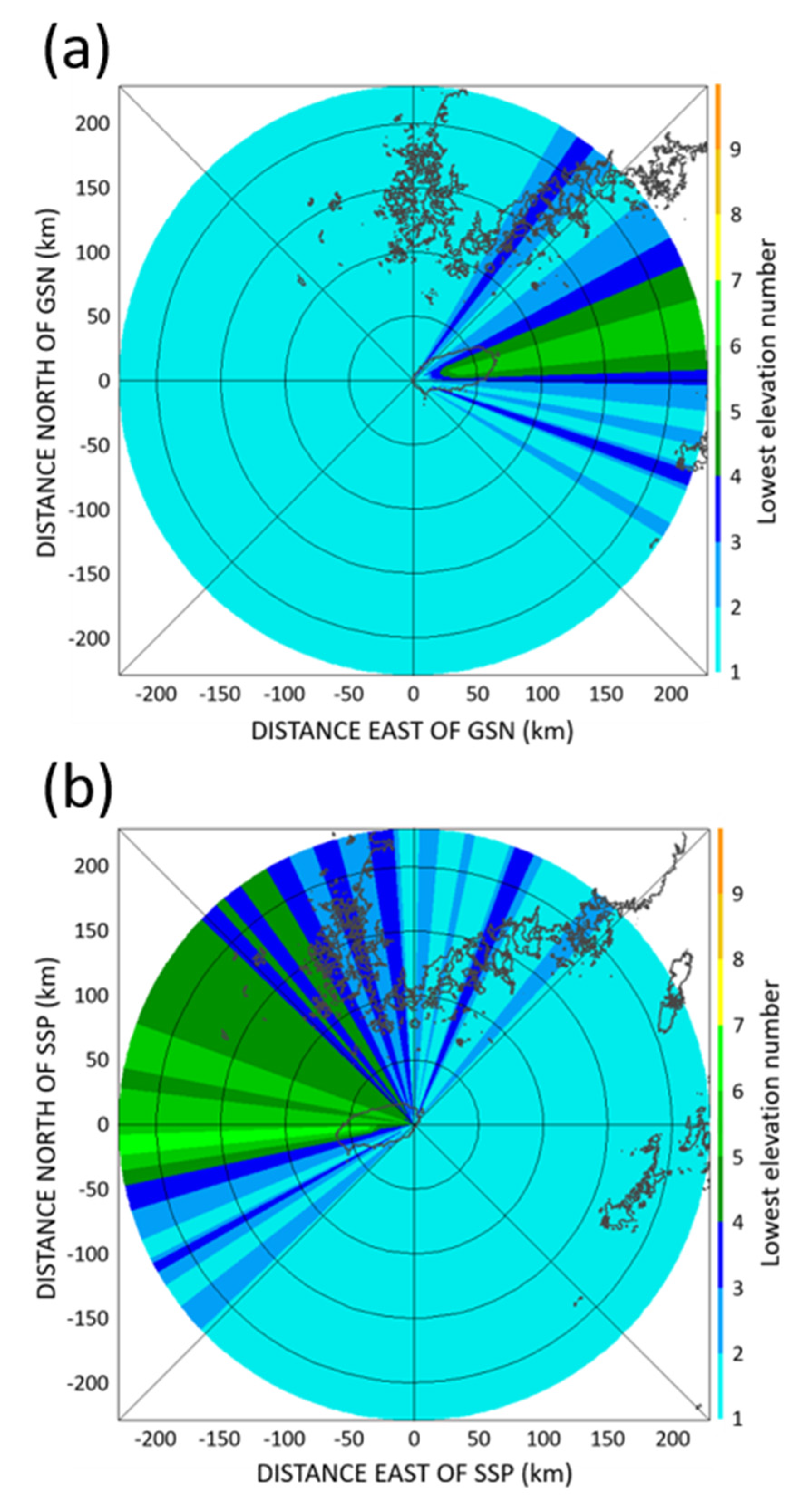

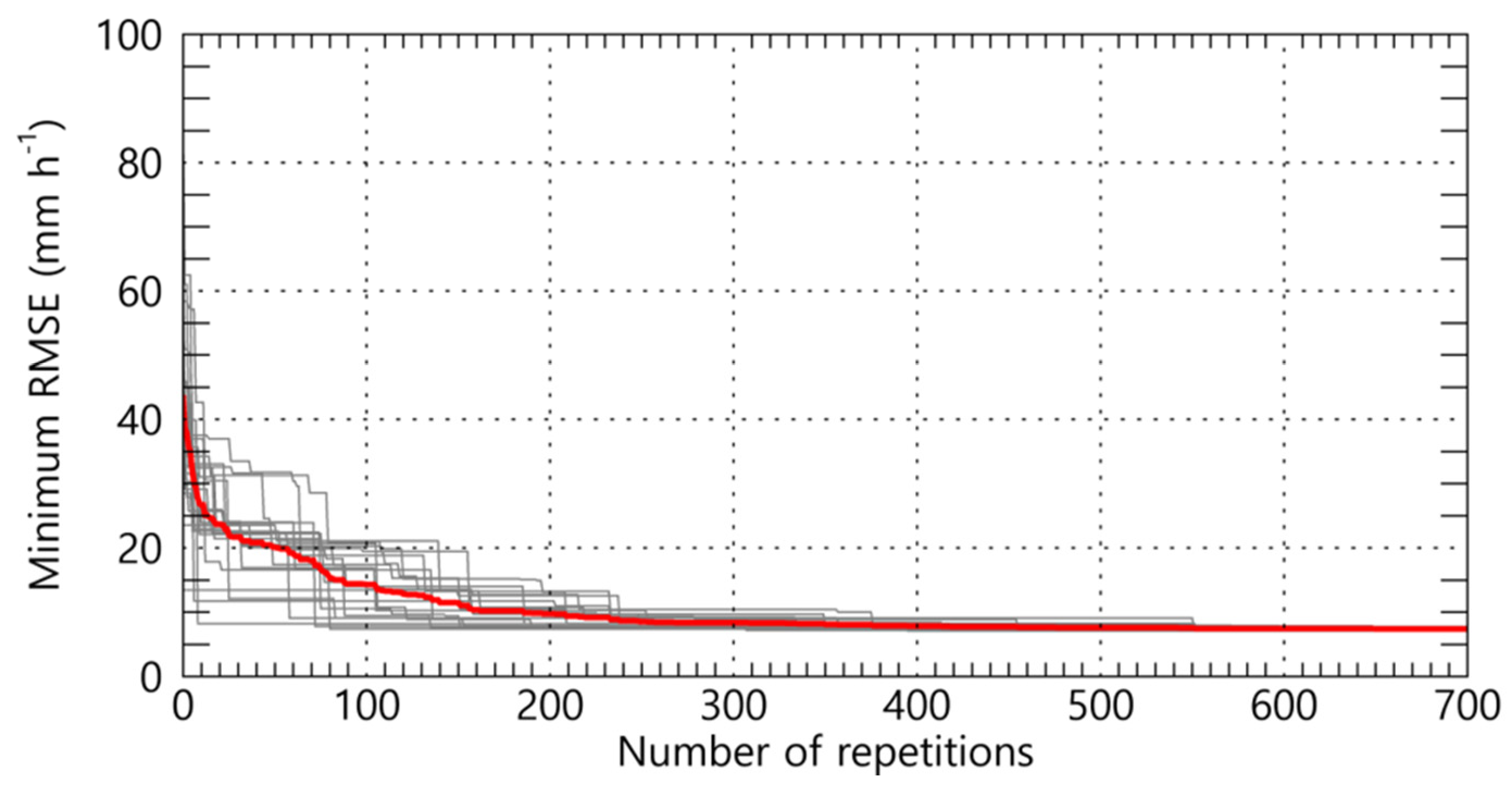
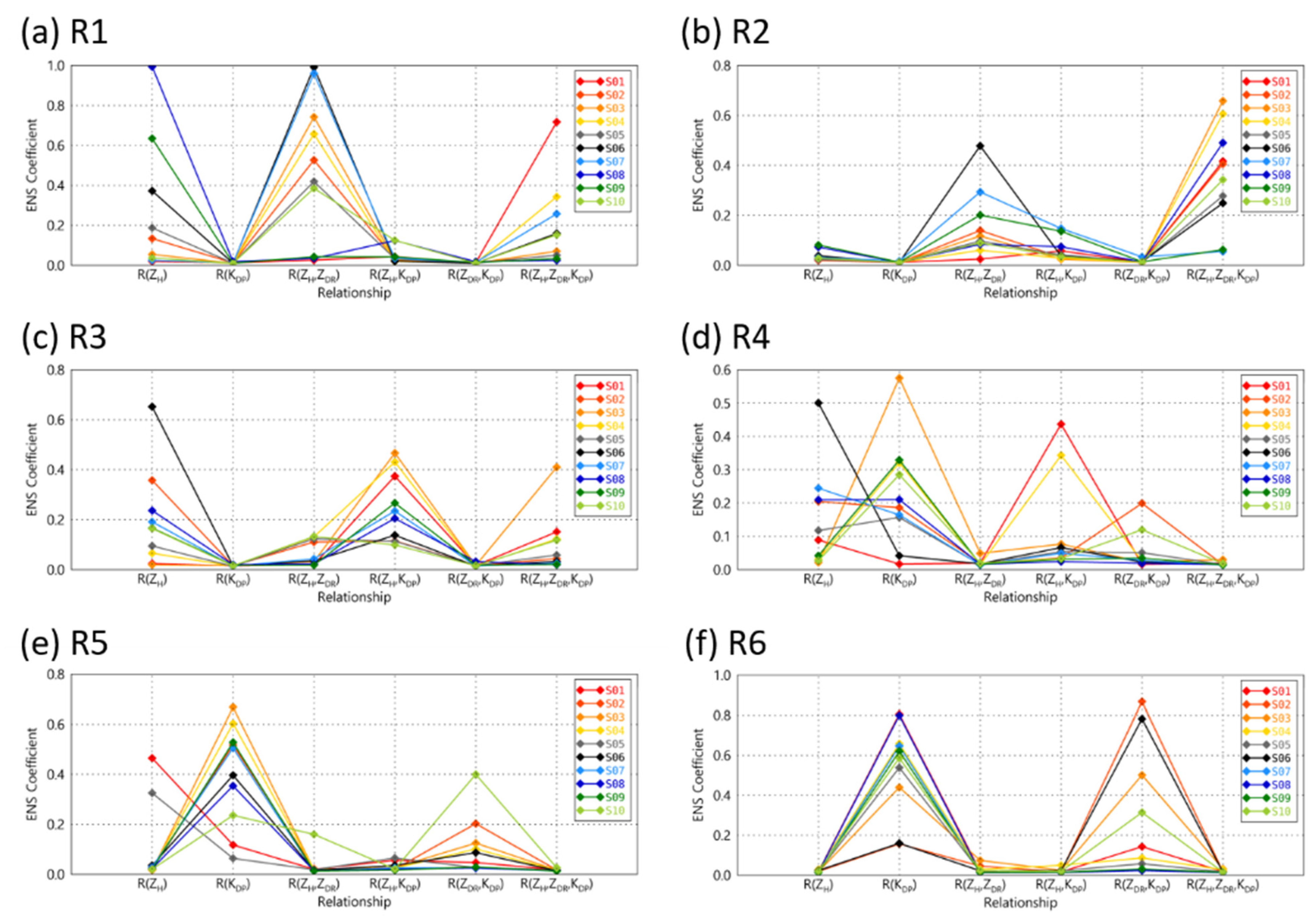

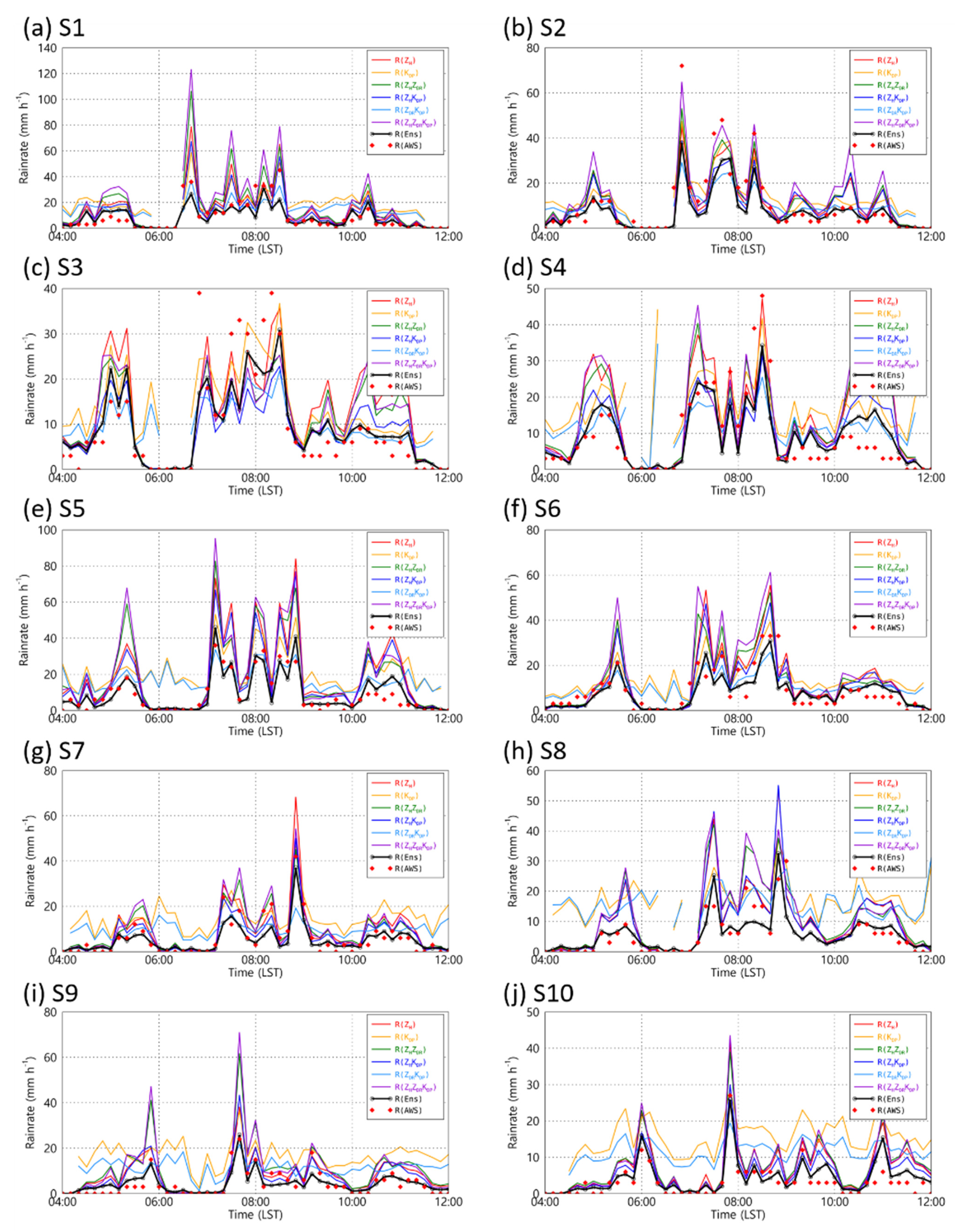
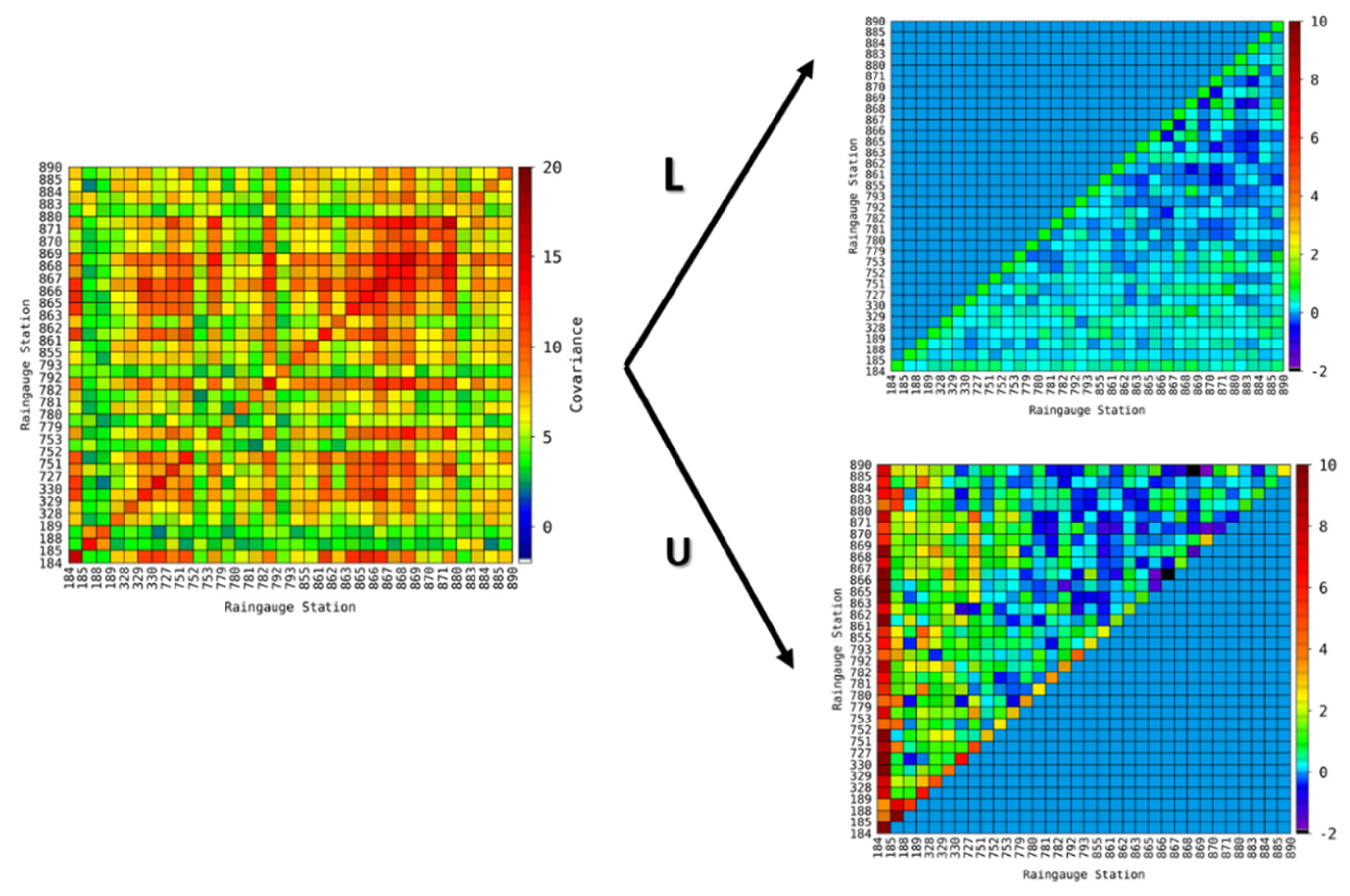
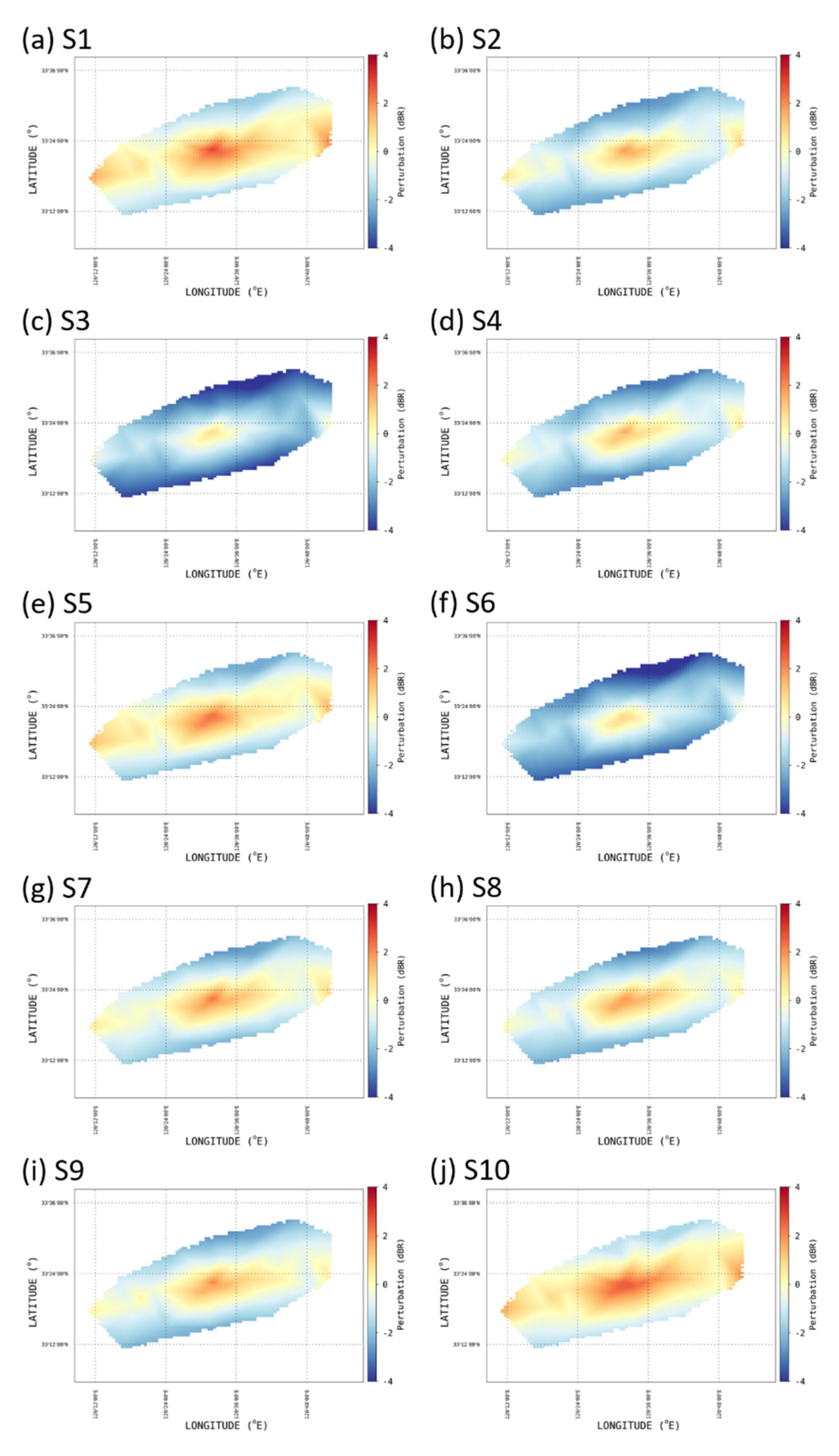
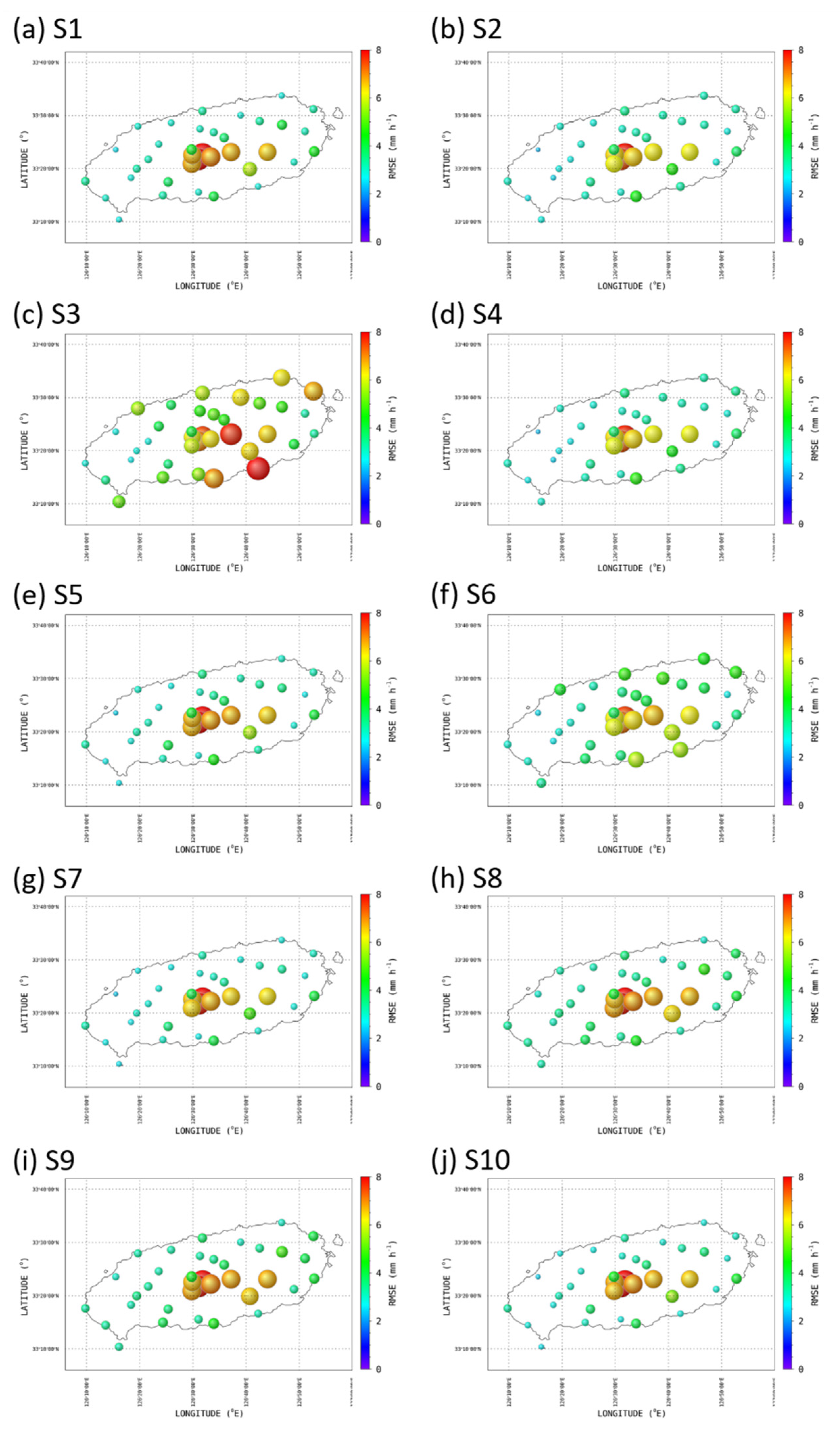

| Observation Year | Observation Period |
|---|---|
| 2012 | 27 June–13 July |
| 2013 | 18 June–14 July |
| 2014 | 19 June–14 July |
| Site | Latitude (°, N) | Longitude (°, E) | Altitude (m) |
|---|---|---|---|
| S1 | 33.3000 | 126.2056 | 37 |
| S2 | 33.1394 | 126.2717 | 140 |
| S3 | 33.3450 | 126.3214 | 324 |
| S4 | 33.3469 | 126.3883 | 551 |
| S5 | 33.4250 | 126.4036 | 330 |
| S6 | 33.3919 | 126.4939 | 975 |
| S7 | 33.4253 | 126.5303 | 571 |
| S8 | 33.4303 | 126.5978 | 590 |
| S9 | 33.4594 | 126.7033 | 332 |
| S10 | 33.5172 | 126.8869 | 57 |
| Parsivel Disdrometer | Technical Data | |
|---|---|---|
| Wavelength of the optical sensor | 780 nm | |
| Measuring area | 180 × 30 mm (54 cm2) | |
| Measuring range | Particle size | 0.2–25 mm (32 channels) |
| Particle velocity | 0.2–20 m s−1 (32 channels) | |
| Precipitation intensity | 0.001–1200 mm h−1 | |
| Measurement interval | 10 s to 60 min | |
| Dimensions (H × W × D) | 670 × 600 × 114 mm | |
Publisher’s Note: MDPI stays neutral with regard to jurisdictional claims in published maps and institutional affiliations. |
© 2022 by the authors. Licensee MDPI, Basel, Switzerland. This article is an open access article distributed under the terms and conditions of the Creative Commons Attribution (CC BY) license (https://creativecommons.org/licenses/by/4.0/).
Share and Cite
You, C.-H.; Suh, S.-H.; Jung, W.; Kim, H.-J.; Lee, D.-I. Dual-Polarization Radar-Based Quantitative Precipitation Estimation of Mountain Terrain Using Multi-Disdrometer Data. Remote Sens. 2022, 14, 2290. https://doi.org/10.3390/rs14102290
You C-H, Suh S-H, Jung W, Kim H-J, Lee D-I. Dual-Polarization Radar-Based Quantitative Precipitation Estimation of Mountain Terrain Using Multi-Disdrometer Data. Remote Sensing. 2022; 14(10):2290. https://doi.org/10.3390/rs14102290
Chicago/Turabian StyleYou, Cheol-Hwan, Sung-Ho Suh, Woonseon Jung, Hyeon-Joon Kim, and Dong-In Lee. 2022. "Dual-Polarization Radar-Based Quantitative Precipitation Estimation of Mountain Terrain Using Multi-Disdrometer Data" Remote Sensing 14, no. 10: 2290. https://doi.org/10.3390/rs14102290
APA StyleYou, C.-H., Suh, S.-H., Jung, W., Kim, H.-J., & Lee, D.-I. (2022). Dual-Polarization Radar-Based Quantitative Precipitation Estimation of Mountain Terrain Using Multi-Disdrometer Data. Remote Sensing, 14(10), 2290. https://doi.org/10.3390/rs14102290










